This page features special stories and memories from St. John’s History!
1922 – Special Recognition of Pattie Mae Rothtrock in the Lansdale Community (story below written by Pat Reiker)
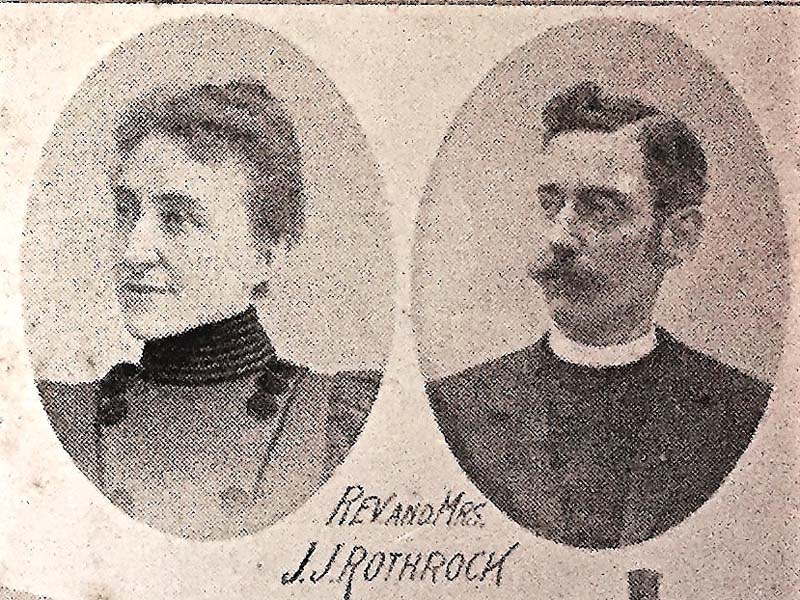
In the Lansdale Semi-Centennial commemorative book (1922), this passage appears in the Red Cross section: “The Red Cross feels proud in mentioning among its capable workers, Mrs. J. J. Rothtrock, who knitted and contributed, through the Red Cross and private channels, the following:
23 boys’s sweaters, 5 sweaters for nurses’ 40 pair of stockings; 4 pair wristlets, 3 scarfs, 22 helmets. Inasmuch as Mrs. Rothtrock always said she was knitting for ‘The Boys’ or for ‘Her Boys,’ it is very appropriate to call her ‘The Mother of the Lansdale Soldier Boys.'”
Rev. J.J. (Jacob J.) Rothrock (St. John’s Pastor 1885-1922) and Pattie Mae Rothtrock had no children of their own, but Pattie Mae surely adopted a lot of young men with her knitting for the war effort. She must have been very busy, as she would have been the one to answer all church phone calls in the parsonage– there was no church office at the time– and to be a part of the projects of all the women’s groups in the church and many throughout the town. By all accounts, she was a remarkable woman.
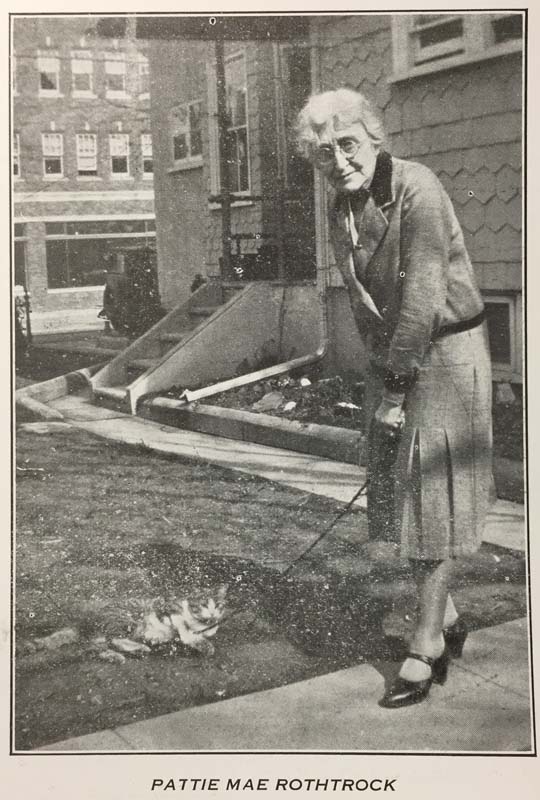
1952 – A World Famous Local Author and Humanitarian Speaks at St. John’s Women’s Guild
For many of us Pearl Buck (1892-1973) is a ‘historical’ figure, a famous author & humanitarian of the past. She served as a Presbyterian missionary from 1914-1932. Her novel “The Good Earth”, set in a pre-World War I Chinese village, won the Pulitzer Prize in 1932 & she was the first woman to win a Nobel Prize in Literature. Her home of 40 years nearby in Bucks County is on the National Register of Historic Places & many of us have toured it, especially when decorated with many trees at Christmas. As a humanitarian, Buck co-founded ‘Welcome House’, the first international, interracial adoption agency.
In 1952, Pearl Buck spoke to the St. John’s Women’s Guild about the Welcome Home project. About 325 persons attended this event! The article below describes her visit & her speech. Some of our long-time current members were there for that event. One important thing you can conclude from this article, the people of St. John’s in 1952 were interested in the same type of ‘justice’ & social issues that we & the UCC continue to support today – and I think Pearl Buck would still feel very much at home today at St. John’s & the UCC!
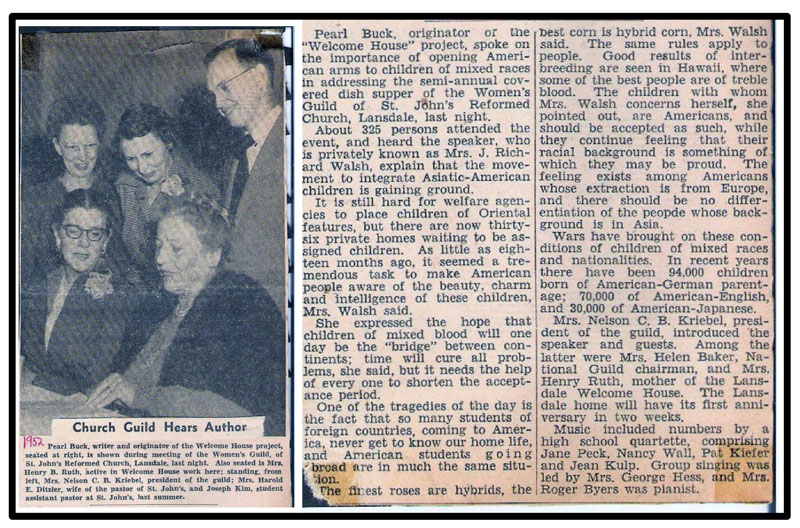
A Grand Day of Music at the Grandest Organ in the World!
We all enjoyed the beautiful music of our retired Minister of Music David Furniss playing our St. John’s organ for over 30 years, and maybe you heard him play in concert at a nearby church, and know he’s a member of the American Guild of Organists, but only a few of us were there the day he played the grandest organ of them all – the Wanamaker Organ at Macy’s Center City, Philadelphia! The Wanamaker organ was built for the 1904 St. Louis World’s Fair, then purchased and moved in pieces by train to Philadelphia by John Wanamaker, who envisioned it as the centerpiece of his grand new department store at 13th & Market Streets. After 2 years to rebuild it, the organ first played in the store on June 22, 1911 at the exact moment when British King George V was crowned. It has been for years considered the largest working pipe organ in the world, although the recently restored Atlantic City Convention Center organ compares in size in some measures.
We move ahead in our story almost 100 years to November 2, 2010, when then – Associate Pastor Ryan Henderson led a group of our youth & adults on a day train trip to center city Philadelphia, touring the grand Masonic Temple, the SEPTA Museum, and then to Macy’s in the Grand Court, where Ryan promised a surprise for the St. John’s group. Then we looked up to watch as our own David Furniss sat at the grand organ and played several songs for the daily public noon concert! David received a rousing round of applause from all that were gathered there in the Macy’s Grand Court, but was especially cheered on by our St. John’s group gathered around the famous ‘Eagle’!
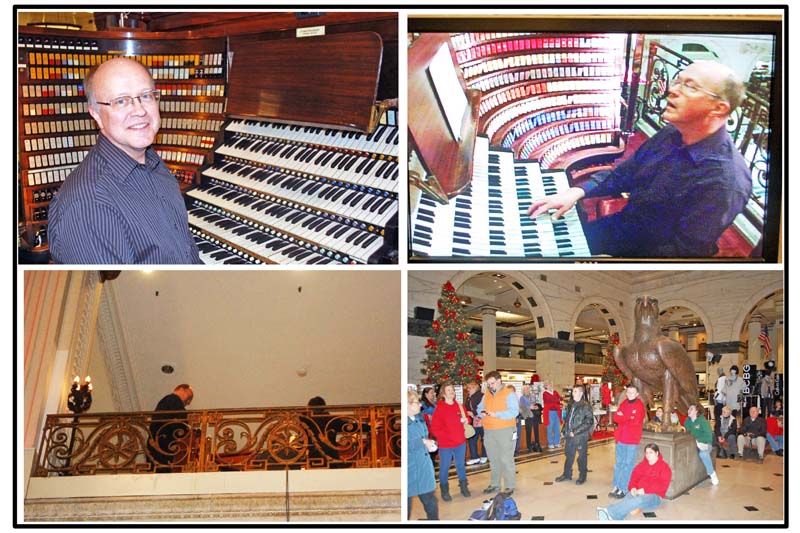
David admitted afterwards that the didn’t quite use all the keys & stops while playing the Wanamaker Organ at Macy’s that day, but it sounded good to those of us fortunate enough to be there in Macy’s Grand Court that day!
story submitted by & photo by John Hendricks
When Is A Window Not A Window?
As we have documented on our website, our beautiful St. John’s church building was started in 1925 with the classrooms/offices building dedicated in 1926, the Assembly Hall dedicated in 1937, then the long wait through the end of the depression and World War II until the sanctuary was completed and dedicated in 1953. The first service in the new sanctuary took place before the dedication on Christmas Eve, December 24, 1952 – imagine the crowds, the excitement, the wonder of that Christmas Eve at St. John’s!
Of course one of the spectacular sights greeting those worshiping her for the first time were the beautiful stained glass windows, selected by pastor Rev. Harold Ditzler. But one thing wasn’t quite right – a blank wall in the sanctuary where there was no window – because behind that wall was an inside room, what we today call the Library! I don’t know the rest of the story – was there a plan in place at that time to fill in that space, or was it something someone noticed after the sanctuary was ‘completed’.? However it happened, a wonderful solution was found. The empty wall was painted to look like another of our beautiful windows! The transept window was dedicated during worship on September 30, 1956, fully completing our sanctuary!
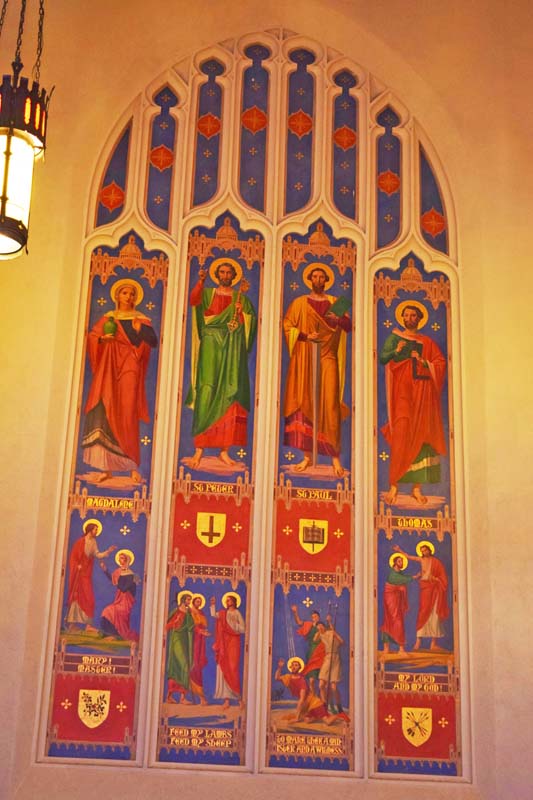
story submitted by & photo by John Hendricks
St. John’s Wasn’t Built In A Day!
All of us admire our beautiful church building, and you may think of the beautiful stonework and our tower that can be seen for blocks as a work of art. But did you know that it took over a quarter century to build?
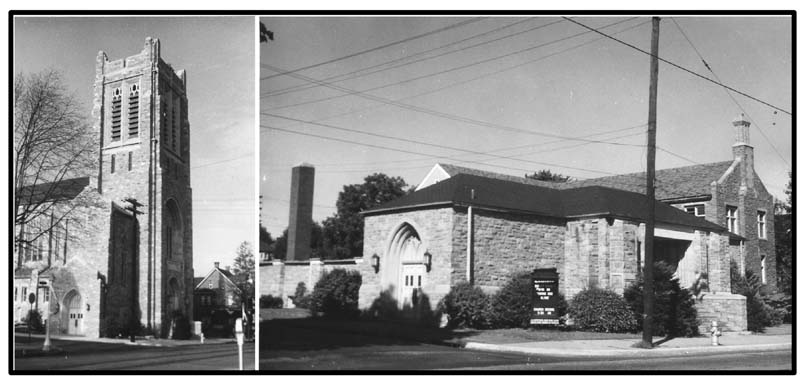
The story begins with ground breaking for the St. John’s Reformed Church Sunday School building on March 29, 1925, with the cornerstone laid July 26, 1925 and the celebration for the dedication of the building on June 13, 1926. All of the plans were in place to build the Assembly Hall, then the sanctuary above it. Then came the Great Depression, and suddenly the plans to finish the building were on hold. It was another ten years before ground could be broken for the Assembly Hall on June 29, 1936, with the cornerstone laid on September 27, 1936 and the dedication on April 18, 1937. Now St. John’s Evangelical & Reformed Church had a beautiful Sunday school building and the below ground level Assembly Hall, topped above ground level with beautiful gothic stone steps leading to a temporary flat roof!
Once again, plans were put on hold as World War II began, and materials and workers concentrated on materials for the war effort. Worship moved from the old church building next door (which the congregation had outgrown) to the Assembly Hall. Finally, after the war, there was a renewed commitment to build the sanctuary, and Rev. Harold Ditzler, a pastor with a good reputation for getting church buildings finished, was installed as our pastor in 1949. The campaign to raise the final funds and finish construction was on, with the slogan “a pew for you in ’52”! And the sanctuary was finished that year, with the first worship service in the new sanctuary celebrated on Christmas Eve, December 24, 1952. The new sanctuary was dedicated on March 22, 1953. It must have seemed like ‘forever’ to the St. John’s family from the ground breaking in 1925 to the dedication in 1953, but our dedicated forebearers took on the task and left for us the beautiful building we have now dedicated to God’s work for over 60 years!
story submitted by John Hendricks, photos by Earl Swartley
The Sights, Sounds and Smells of Worship at St. John’s
At St. John’s 125th anniversary celebration on October 7, 2001, one of the special guests was Mae Baer, the wife of St. John’s late Pastor Rev. Harold C. “Cubby” Baer, who was senior pastor from 1944-1949. She told the story that in those days, the old church building was directly connected by a hallway to the manse, the home of the pastor and his family, the building we now call ‘Anchor House’ just east of the present church building on Richardson Avenue. On Sundays, just before worship, she would put a roast in the oven to cook during the service so it was ready for a noon Sunday dinner. As the service went along, the sanctuary would fill with the wonderful aroma of her Sunday dinner cooking next door, just like it does today on the Sundays of our Congregational Dinners! I wonder how many people attending church got themselves invited for Sunday dinner! (Mae Baer passed away May 6, 2012 a week shy of age 101.)
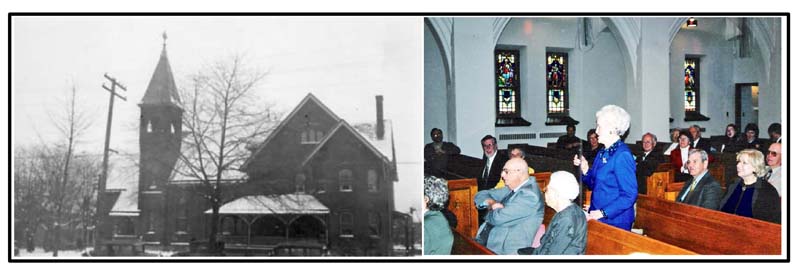
story submitted by John Hendricks, photos by Earl Swartley & John Hendricks
Special Surprise for our St. John’s MLK Day Youth Volunteers
Over the years, our youth have participated in projects in Philadelphia, Chester, and in our own community the weekend of the Dr. Martin Luther King, Jr. Holiday/Day of Service. One of the highlights was a project of cleaning up a park in Chester, Pa. in 2009 named for Dr. King, next to the Chester public library, near where Dr. King had attended Crozier Theological Seminary. When we returned to work there the MLK holiday weekend in 2010, we found a beautiful bust-sculpture of Dr. King had been erected in that park!
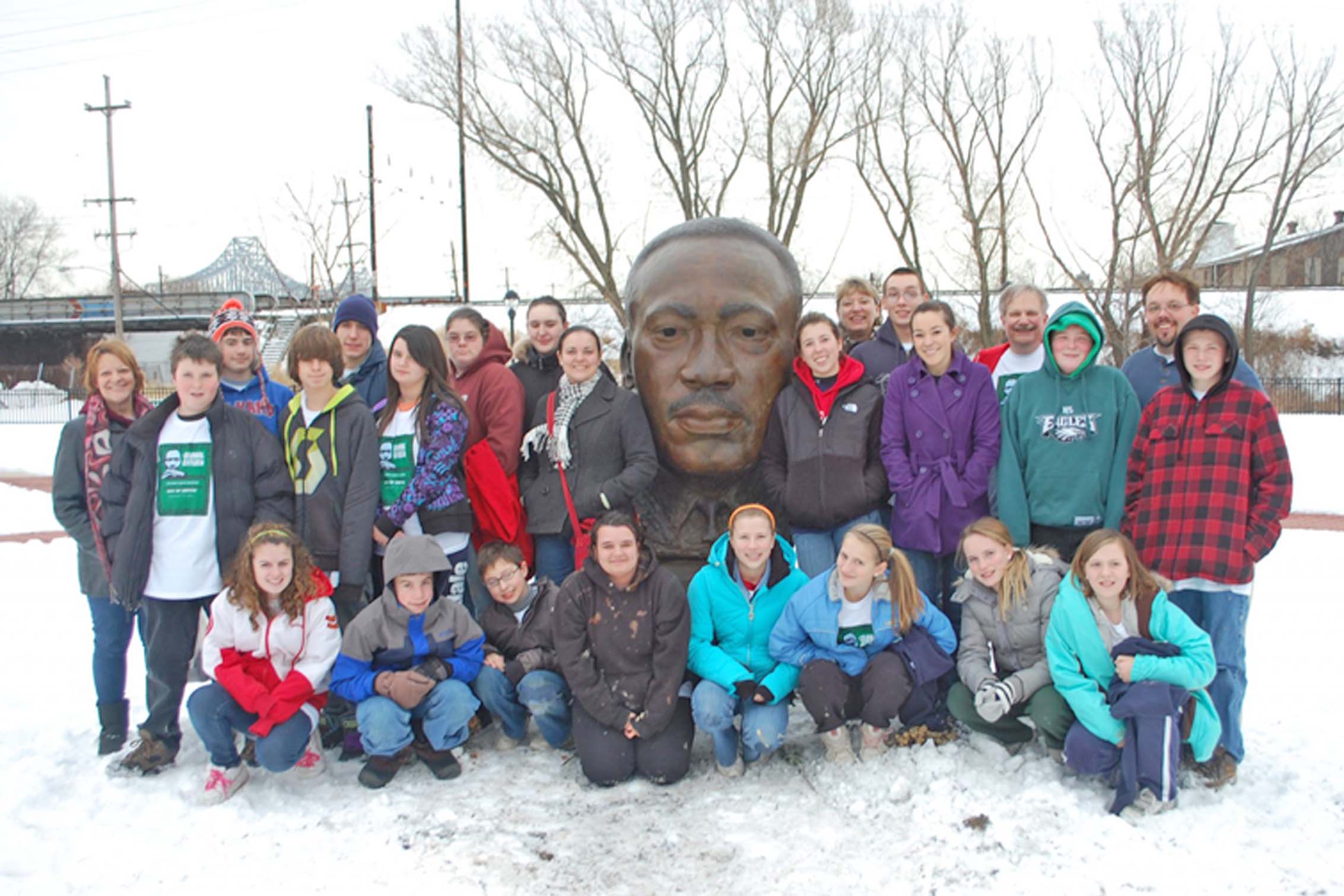
story and photos submitted by John Hendricks
Seeking the Truth: St. John’s MYTH-Information Debunked!
Not all of the rumors told about St. John’s are true – like the rumor about our 1st pastor!
In all of the St. John’s archives there was little known or written about St. John’s first pastor from 1879-1884, Rev. Henry Franklin Seiple. His impressive portrait hangs on the church library – the man who resembles one of the ‘Smith Bros.’ from the cough drop packages! The archives tell nothing of his circumstances in leaving St. John’s after five years. With no facts available, there were rumors that circulated about him years ago, even the story that while he was pastor he jumped from a window to an early passing!
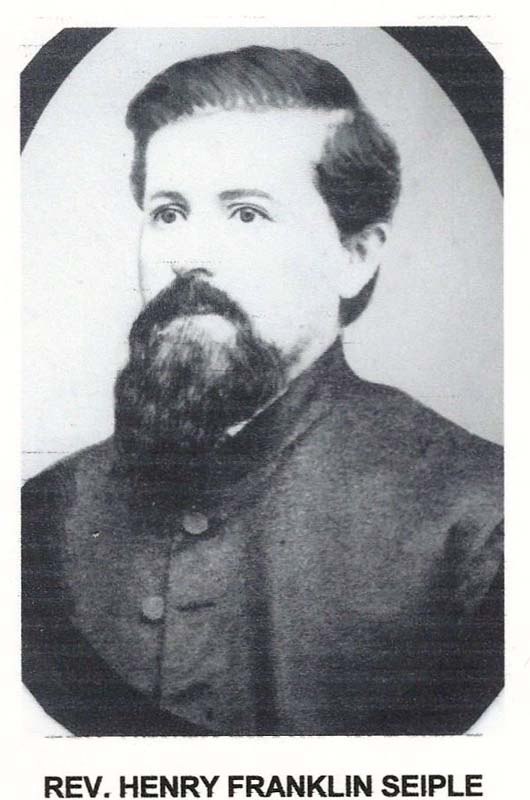
A few years ago I set out to find the truth, searching for Rev. Seiple on the internet in the late hours of the night. There was nothing found, until one night a breakthrough – an article in the history of St. Luke’s church in Dublin, Pa. had misspelled his name as Siepel! Suddenly I had information to build his story.
Rev. Seiple was born in 1843 and appointed as our first pastor in 1879 by the Hilltown Charge that was overseeing the start-up of St. John’s & voted as pastor by the congregation June 30, 1879 (for the annual pay of $550 dollars). The history of St. Luke’s also shows he became their ‘English’ pastor in 1879 (he preached there every three weeks with a German pastor the other two), so apparently his duties were shared between the two churches. In 1881 he became the full time pastor in Dublin. In 1884 St. John’s became ‘detached’ from Hilltown and it’s own congregation. The records are not available, but one can speculate St. John’s decided to elect a new, full time pastor, with Rev. Seiple continuing to work in Dublin.
The records do indicate that Rev. Seiple and his family continued to live in Lansdale while pastor in Dublin, and also he helped form and was first leader of the Masonic Lodge in Lansdale in 1882. He preached his last sermon in Dublin in 1897. He suffered from diabetes and was blind the last year of his life, passing away October 22, 1908 at age 65, with his funeral at his Lansdale home.
While he was ill in later life and his exact circumstances for leaving St. John’s seem lost to history, the rumor he had taken his life at an early age was certainly untrue. There were several part time preachers before him at St. John’s and Rev. JJ Rothtrock was the first pastor with St. John’s on it’s own, but Rev. H.F. Seiple played an important role in establishing St. John’s and leading as our first ‘official’ pastor!
story submitted by John Hendricks, picture from St. John’s archives
Honoring Our St. John’s UCC ‘Pioneers’
Herman C. Ahrens, Jr.
If you attended St. John’s regularly in the past 60 years you knew Herman Ahrens, who was active in adult Sunday School teaching & in supporting our youth programs. You may not have known Herman was a leader in our United Church of Christ denomination and our Penn Southeast conference! Herman was the editor of “Youth” Magazine from 1950 to 1981, distributed to all youth throughout the UCC and beyond. Following that position, Herman was commissioned as Minister of Communications for the PSEC from 1986 to 1992 when he retired, but he remained active in may ways at St. John’s until he passed away after a very active life at age 91 on February 24, 2016.
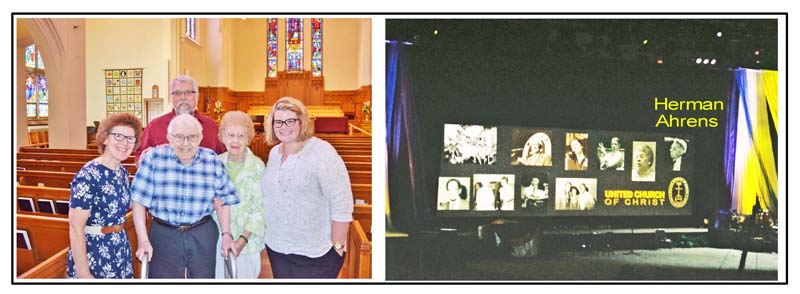
A delegation of our St. John’s youth and adults attended the UCC’s 50th anniversary General Synod event in Hartford, Ct. in 1987. All were surprised to see a picture of Herman Ahrens on the big screen on stage, honoring 50 important UCC founders!
story and photo submitted by John Hendricks
A St. John’s Connection to The First Man on the Moon, Neil Armstrong. Longtime St. John’s member Lorene Ahrens was a neighbor and church friend of Armstrong. The following article was published in The Reporter newspaper in July, 2009.
Man on the moon – Local woman recalls childhood friendship with Neil Armstrong
By DAN SOKIL Staff Writer – Monday, July 13, 2009 The Reporter, Lansdale, PA.
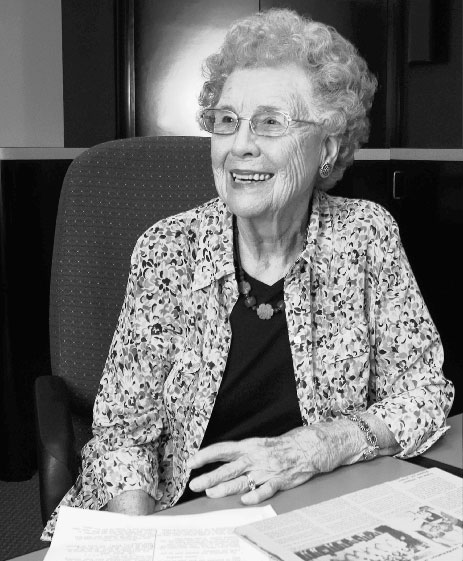
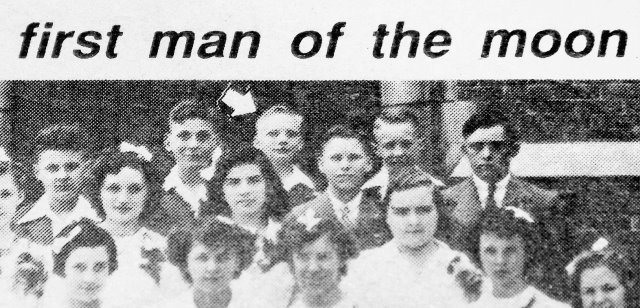
Photo of astronaut Neil Armstrong, back center under arrow, from a 1989 newspaper clip from Lorene Aherns. Armstrong was part of a church group in Upper Sandusky, Ohio, in the 1940’s, and attended the church where Lorene’s father was pastor. The clip was from a story marking the 20th anniversary of the first moon landing.
Lorene Ahrens (maiden name Kellermeyer) moved to Lansdale from Ohio in 1950, but she still remembers the nights she and her sister Janice spent growing up in Upper Sandusky, Ohio. They’d go to church and Sunday school every week, and play outside with the kids from down the street at night, including one who took one very famous small step 40 years ago today. That man was Neil Armstrong.
“Neil’s father, Mr. Stephen Armstrong, was an auditor for the state of Ohio, and he and their family were stationed in various county seats in northwestern Ohio, so the Armstrong family lived in Upper Sandusky in the early- to mid-1940s,” said Ahrens.
“My dad (Rev. Hugo C. Kellermeyer) was a pastor, he had started with the church in North Carolina which was where I was born, but we moved to Ohio in January 1942 and so we knew the Armstrong family through Trinity Evangelical and Reformed Church,” she said.
Janice and Neil were the same age, but Lorene, despite being two years younger, still remembers weekly croquet games on her family’s front lawn with the neighborhood kids, including one who later became the first man to walk on the moon. “We never wanted to stop playing, and in fact we used to wrap the croquet wicks with white cloth around the end so we could still see them after it got dark,” Ahrens said.
According to Armstrong’s authorized biography, “The First Man” (Simon & Schuster, 2005), Neil lived in Upper Sandusky from 1941 to 1944 before moving on to Wapakoneta, Ohio.
Lorene still remembers car rides to church events with him.
“I remember how when my dad took us to the church camp in the summer, Neil was a very quiet person. He was very, very shy and didn’t talk a whole lot back then, and I haven’t seen him since way back then but from what I read and hear, he’s still very much the same way now,” said Ahrens.
Janice, now living in Nebraska, kept a photo from the church school’s confirmation class of 1943, in which Rev. Kellermeyer can be seen standing to the left of his students; a very young but clearly recognizable Armstrong is in the top row of students.
On a recent trip to her family’s former church in Ohio, Lorene said, she saw a plaque now mounted outside the church that recognizes Armstrong’s confirmation held within. “The really funny thing was that when my sister wrote the class prophecy for the Class of ’47 from Upper Sandusky High School, she wrote that a member of our class would be the first man on the moon,” she said.
“I don’t know what she was thinking when she wrote that, because who wanted to go to the moon in 1947? But she was right, and even though he didn’t actually graduate with her because Neil’s father had been moved to another county by 1947, she’s still had some contact with him because he still goes to their class reunions,” Ahrens said. The family’s story was first told to The Reporter for the 20th anniversary of the moon landing in 1989, when Lorene’s mother, Josephine Kellermeyer, recalled their years in Ohio.
By the time Armstrong and fellow astronaut Edwin “Buzz” Aldrin landed on the moon in 1969, Lorene and her family were camping their way across the country. She watched the lunar landing from a hotel in Phoenix, but Janice dropped his name a few times that night. “She was up in Nova Scotia and couldn’t find a TV to watch the landing, so she started telling people about how Neil was in her high school class, and ended up being interviewed on one of the local radio stations up there,” Ahrens said.
The Ahrens family had one final encounter with the lunar landing as they continued their camping trip: a friend of the family brought them into Johnson Space Center in Houston the day the first moon rocks were brought in from Apollo 11. “Of course, we were just peons so we didn’t get anywhere near them, but there was a definite buzz in the air,” she said.
“My kids and I all remember Alan Shepard cruising by as we stood outside one of the offices and giving us a once-over, thinking ‘Who are these people?’ That was the closest I’d ever been to an astronaut, except for Neil Armstrong many years ago.”
story and photos from The Reporter July 13, 2009
